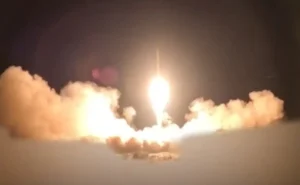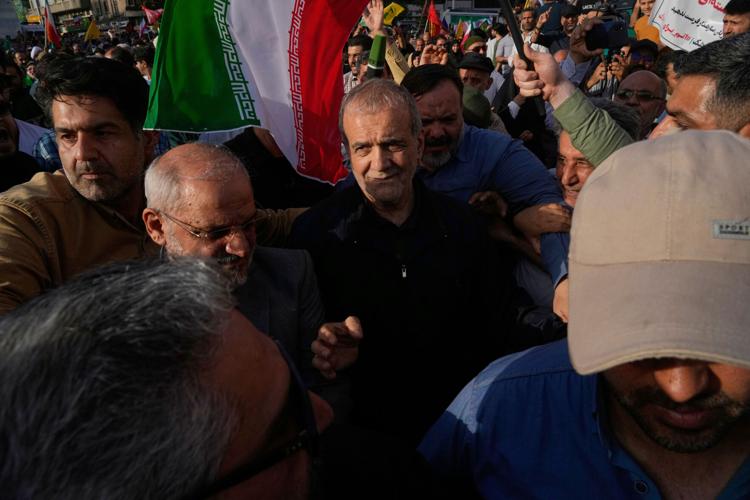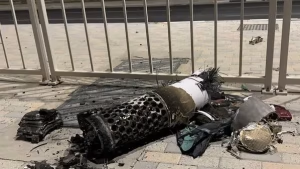New Delhi – In a dramatic escalation of tensions in the Gulf region, Iran has released a video claiming Iran Attack On US Base In Qatar, at the Al Udeid Air Base in Doha, Qatar. The assault was carried out by the Iranian Revolutionary Guard Corps in response to recent American airstrikes on Iran’s nuclear facilities. This marked a major shift in the ongoing geopolitical friction in the Middle East, triggering widespread condemnation and concern from international stakeholders.

The video, allegedly released by Iranian officials, captures the launch of a missile from within Iran, purportedly targeting the U.S. military installation located in the Qatari capital. The type of missile used during the Iran Attack On US Base In Qatar remains unidentified, with military analysts still assessing the footage for verification.
Operation Besharat Fatah: Iran’s Tactical Response


Iran has codenamed its retaliatory military maneuver as Operation Besharat Fatah. According to the statement from Iran’s Supreme National Security Council, the number of missiles launched in the Iran Attack On US Base In Qatar matched the total bombs dropped by the United States during its recent strikes on Iranian nuclear sites.
Interestingly, the targeted U.S. base was located away from densely populated civilian zones, suggesting a calculated effort to avoid civilian casualties. Iran’s operation was seemingly a tit-for-tat retaliation designed to mirror the scale of the American offensive while attempting to adhere to the law of armed conflict.
Casualties And Defensive Measures In Qatar


As of now, there have been no reported casualties resulting from the Iran Attack On US Base In Qatar. Qatar’s air defense systems were promptly activated during the incident, successfully minimizing damage. The missile strike, though significant, appears to have been executed with caution to avoid broader regional destabilization.
Advance Warning Reportedly Given To Qatar
Interestingly, a credible report has indicated that Iran had informed Qatar in advance of its intended missile operation. This early communication may have allowed Qatar to prepare its defense systems, which likely contributed to the absence of casualties or substantial infrastructure damage at Al Udeid.
This revelation also suggests that while Iran is seeking to deliver a strong military message through the Iran Attack On US Base In Qatar, it is also attempting to avoid unintended escalation with non-target nations.
American Operation Midnight Hammer Sparks Retaliation


Just a day prior to the Iranian strike, the United States had conducted a significant air operation against Iranian nuclear facilities. Codenamed Operation Midnight Hammer, this offensive targeted critical nuclear infrastructure, including the Fordow, Natanz, and Eshafan sites.
Seven B-2 Spirit bombers participated in the mission, marking the first time that the U.S. deployed the GBU-57 Massive Ordnance Penetrator (MOP) bomb in combat. The operation was executed over a narrow window between 6:40 p.m. and 7:05 p.m. Eastern Time, dropping a total of 14 MOPs on Iran’s most fortified nuclear locations.
The strategic intent behind the operation was clear—to disable Iran’s nuclear capabilities and send a powerful signal. However, the unprecedented nature of the direct attack prompted an equally strong response in the form of the Iran Attack On US Base In Qatar.
Use Of Revolutionary Guard Corps In Offensive
The Iranian Revolutionary Guard Corps (IRGC) played a central role in executing the missile strike. Known for their elite status and high command loyalty, the IRGC’s involvement indicates the seriousness and high-level authorization of the operation.
A spokesperson for Iran’s Armed Forces confirmed the IRGC’s operational leadership in the Iran Attack On US Base In Qatar, adding that the military response was carefully calibrated and fully justified under the right of self-defense.
Symbolism Behind Target Selection And Retaliation


By selecting Al Udeid—the largest U.S. base in the region—Iran intended to strike both militarily and symbolically. The Iran Attack On US Base In Qatar communicates Tehran’s readiness to counter American intervention and marks a departure from traditional proxy tactics often used by Iran.
The timing of the operation, shortly after a direct U.S. strike, also emphasizes Iran’s willingness to operate openly and with precision. The geopolitical message is unmistakable: Iran is asserting regional dominance and deterrence.
First Combat Use Of GBU-57 Bomb By U.S. Forces

The U.S. strike, which triggered the Iranian response, marked the first combat use of the GBU-57 Massive Ordnance Penetrator bomb. This bunker-busting weapon is designed specifically to penetrate hardened underground facilities and can only be carried by the B-2 bomber.
Each GBU-57 weighs over 30,000 pounds and is capable of destroying fortified targets, such as Iran’s deeply buried nuclear bunkers. The usage of such powerful weaponry in Operation Midnight Hammer likely intensified the urgency of the Iran Attack On US Base In Qatar.
Implications For Regional Security And Diplomacy
The Iran Attack On US Base In Qatar significantly raises the stakes in the ongoing U.S.-Iran confrontation. It brings forth the potential for broader regional instability, especially considering the strategic locations involved and the scale of the weaponry deployed.
Diplomatic channels may soon be tested to prevent further escalation, with the Gulf nations, in particular, walking a tightrope between regional stability and defense cooperation with Western allies.
The events have also raised alarms in the international community over the potential for further military confrontations, especially involving nuclear-capable states in a geopolitically sensitive area.
Conclusion
The Iran Attack On US Base In Qatar is a pivotal development in the ongoing geopolitical drama between Tehran and Washington. It represents a bold and calculated response to a direct U.S. strike, shifting the narrative from shadow wars and cyber battles to open conflict involving state forces and military infrastructure.
Both nations now stand at a crossroads—one path leading to heightened military confrontation and another toward a possible diplomatic reset. The coming days will be crucial in determining the trajectory of this high-stakes conflict in the Middle East.

